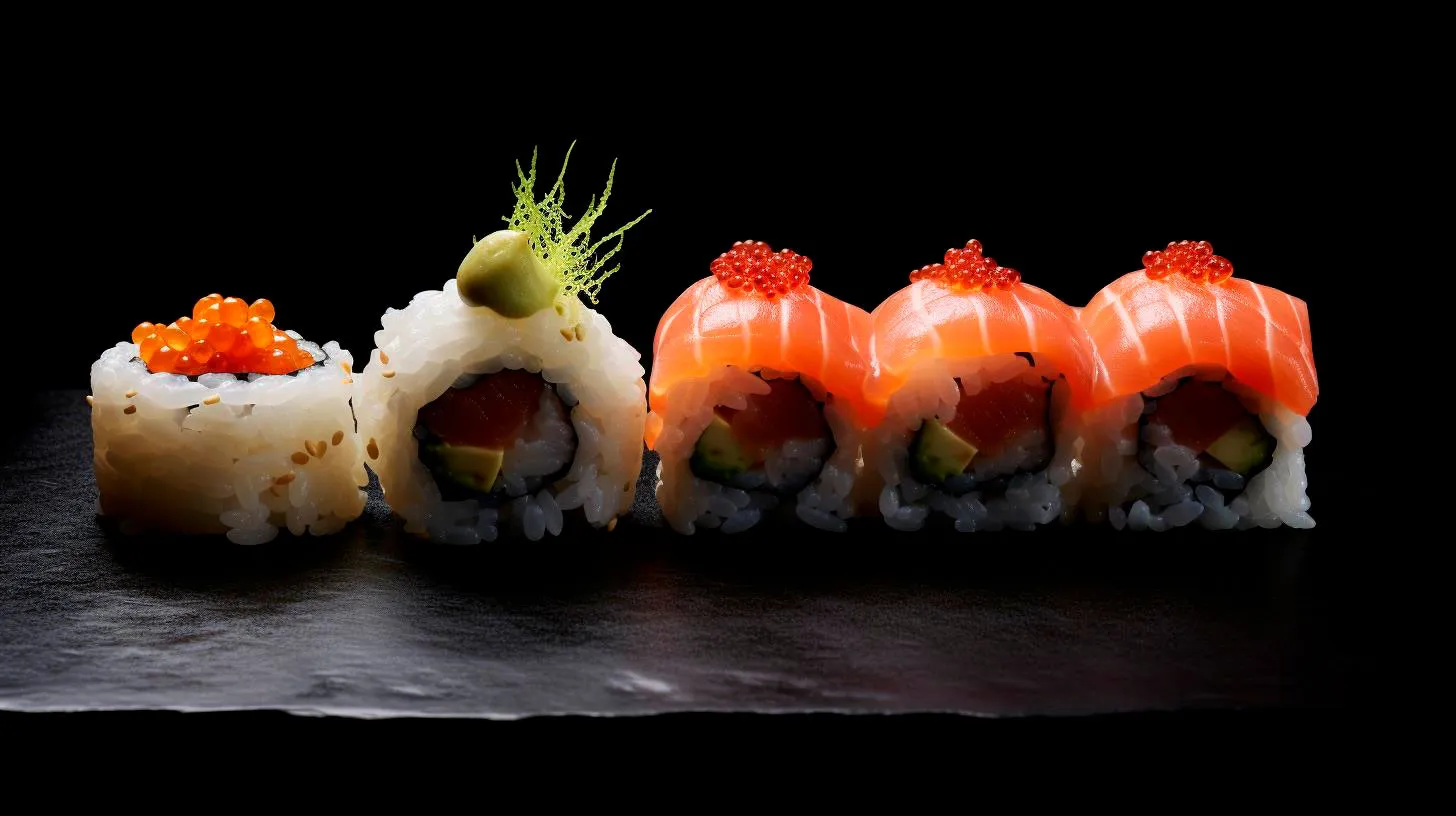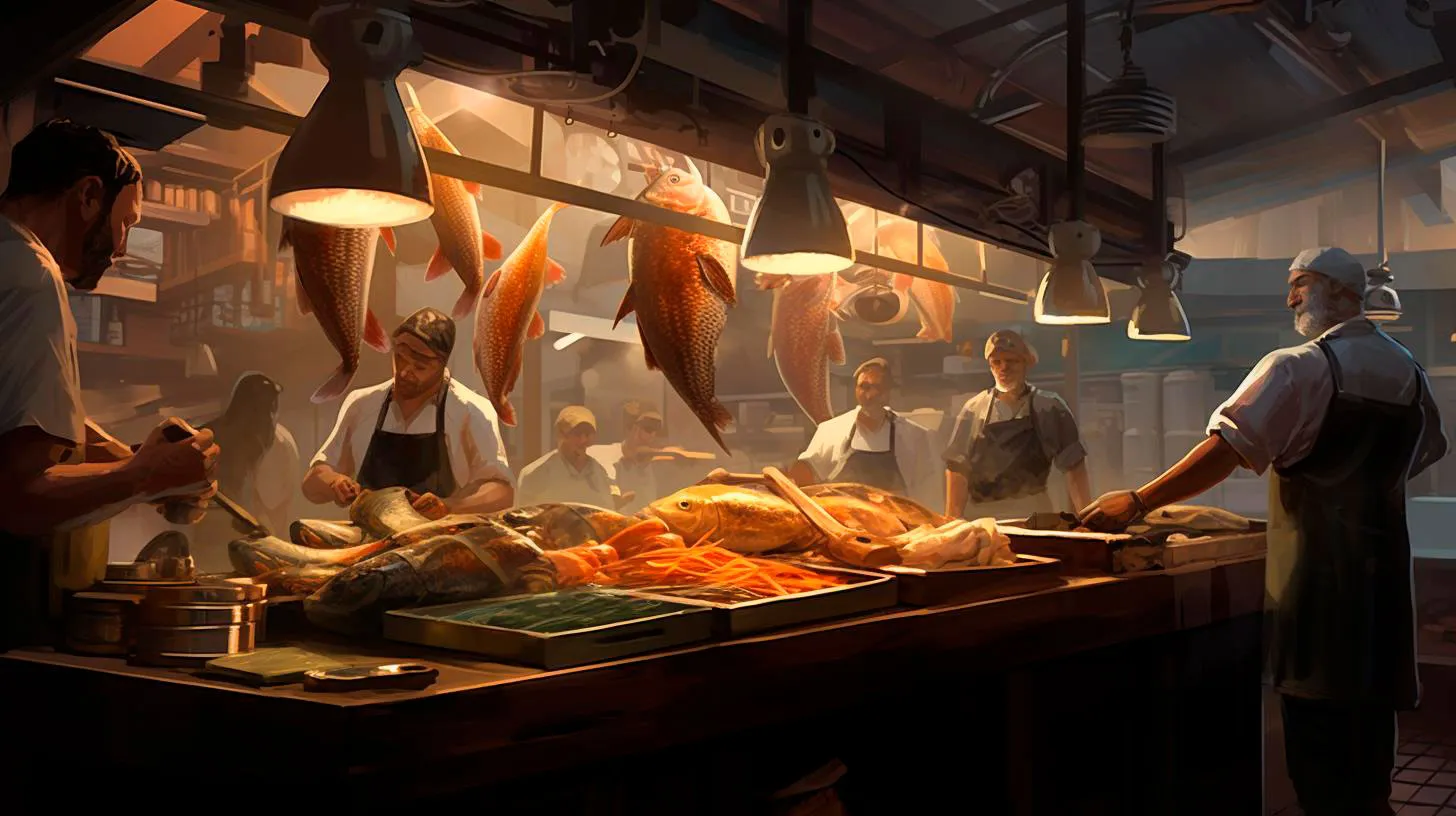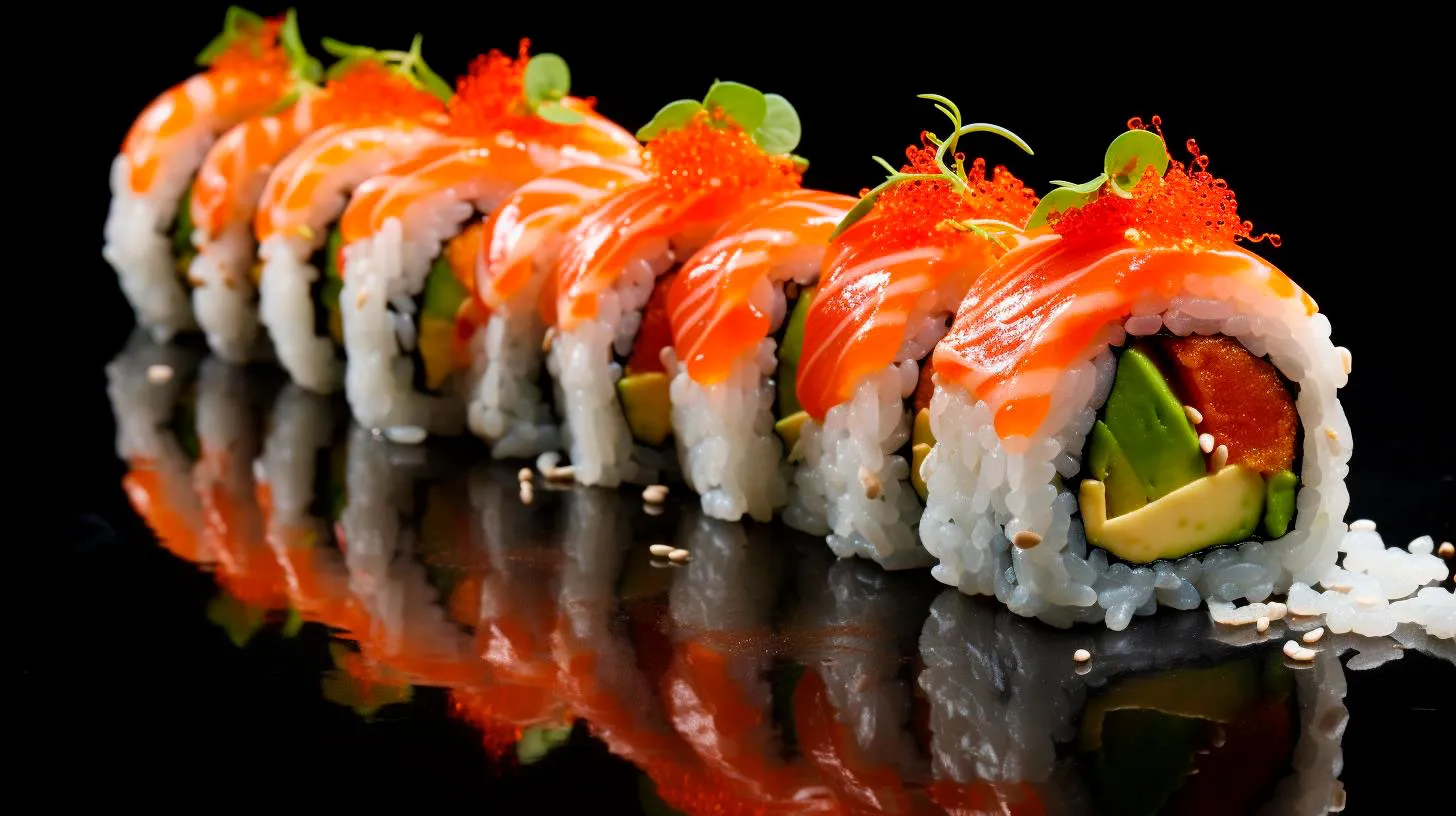The Evolution of Sushi: A Chef’s Path towards Mastery
In this article, we will trace the remarkable journey of sushi, exploring its history, ingredients, techniques, and the path a chef takes towards mastering this revered cuisine.
The Origins of Sushi
The roots of sushi can be traced back to the 2nd century AD in Southeast Asia. Initially, sushi was a method of preserving fish by fermenting it with rice and salt. This process, known as narezushi, allowed the fish to be stored for months, making it a valuable staple in a region where fresh fish was not always readily available. Over time, the fermentation process was refined, resulting in a more palatable dish.
While sushi gained popularity in Southeast Asia, it was in Japan where it truly flourished and evolved into the art form we know today. In the 18th century, a key innovation occurred when a Tokyo-based chef named Hanaya Yohei introduced a new style of sushi called nigiri sushi. This involved placing a small portion of vinegared rice on top of a slice of fresh fish, creating a visually appealing and delicious bite-sized delicacy.
The Ingredients and Techniques
Central to the art of sushi preparation are two key elements: the ingredients and the techniques employed by skilled chefs. The quality and freshness of the seafood used is paramount. The most common types of fish used in sushi include tuna, salmon, yellowtail, and mackerel. To ensure top-notch quality, sushi chefs often establish direct relationships with local fishermen or rely on trusted suppliers who prioritize sustainable fishing practices.
Equally important, if not more so, is the expertise required to prepare sushi. A sushi chef undergoes years of rigorous training to master the art of sushi-making, known as itamae. They learn the precise knife skills necessary to slice fish with precision, create perfectly shaped rice balls, and master the art of flavor balancing. The techniques employed by these skilled chefs, such as fermentation, marinating, and slicing, contribute to the unique taste and presentation of each sushi piece.
The Path to Mastery
For a sushi chef, the journey towards mastery is an arduous yet rewarding one. They start their career as apprentices, known as wakaimono, spending years honing their skills under the guidance of a master chef. This apprenticeship tradition, called the “kumi,” ensures the transfer of knowledge from one generation to the next, while also instilling a deep respect for traditions and techniques.
During this apprenticeship, aspiring chefs learn the nuances of selecting the freshest fish, the precise timing for fermenting rice, and the art of maintaining a harmonious balance of flavors. They also develop the ability to tailor their sushi creations to cater to individual preferences, ensuring every customer has a unique and memorable dining experience.
The Rewards of Mastery
Mastering the art of sushi brings numerous rewards to a chef. Not only does it provide an avenue for self-expression and creativity, but it also offers an opportunity to delight customers with impeccable culinary skills. A mastery of sushi-making opens doors to prestigious culinary competitions and awards, as well as the possibility of owning and operating one’s own sushi establishment, where one’s creations can be appreciated by a wider audience.
Furthermore, sushi chefs who attain mastery often find themselves in high demand in top-tier restaurants around the world. Their expertise allows them to command significant respect and often entails higher salaries. This recognition of their craftsmanship serves as a testament to the dedication, passion, and skill required to reach the pinnacle of the sushi world.
Key Takeaways
- Sushi has its origins in Southeast Asia, with the fermentation process preserving fish and rice.
- Japan refined sushi-making techniques, most notably with the introduction of nigiri sushi in the 18th century.
- Sustainable sourcing of fresh seafood is crucial in maintaining the quality of sushi.
- Sushi chefs undergo years of apprenticeship to master the art of sushi-making, known as itamae.
- The path to mastery opens opportunities for recognition, creativity, and entrepreneurship.
With its rich history, meticulous techniques, and dedication to excellence, sushi represents the pinnacle of culinary artistry. The path towards mastering this ancient and revered cuisine requires years of dedication, precision, and passion. Sushi chefs, armed with their knife skills, unique flavor combinations, and an unwavering commitment to tradition, continue to push the boundaries of this iconic dish, ensuring its place in global gastronomy for generations to come.
Maintaining Tradition in Modern Times: A Sushi Chef’s Dedication to Excellence
In this article, we will delve into the world of sushi and explore the unwavering commitment that sushi chefs bring to their profession, ensuring the preservation of age-old traditions amidst a rapidly changing world.
Embracing History and Tradition
Sushi, originating in Japan over a thousand years ago, has become a culinary sensation around the globe. Despite the influence of modern cuisine and fusion variations, sushi chefs value the authenticity and rich cultural heritage that their craft embodies. By embracing history and tradition, these chefs keep the essence of sushi alive.
Key Takeaways:
- Sushi chefs hold a deep respect for the origin and cultural significance of sushi.
- They strive to preserve the traditional techniques and methods passed down through generations.
- The emphasis on history in sushi-making sets it apart from other modern culinary practices.
Technique and Precision
Sushi-making is an art form that requires extraordinary precision, attention to detail, and years of practice to master. From selecting the freshest ingredients to crafting delicate rolls with the perfect balance of flavors, every step in the sushi-making process is executed with meticulous care.
Key Takeaways:
- Sushi chefs possess exceptional knife skills, enabling them to slice ingredients with precision.
- They understand the importance of using fresh and high-quality ingredients for an exceptional dining experience.
- Their mastery of rice preparation ensures the perfect texture and flavor.
Prioritizing Customer Experience
One of the defining characteristics of sushi culture is the emphasis on providing an exceptional experience for the customer. Sushi chefs invest their time and effort into creating visually stunning and delectable dishes that leave a lasting impression on their patrons.
Key Takeaways:
- Sushi chefs pay meticulous attention to plating and presentation, enhancing the overall dining experience.
- They offer personalized interactions, such as omakase, where chefs curate a unique menu based on the customers’ preferences.
- By establishing a connection with their patrons, sushi chefs elevate dining into an artful and memorable encounter.
Balancing Tradition and Innovation
While sushi chefs diligently uphold ancient traditions, they also embrace innovation to meet the evolving demands of a modern clientele. By introducing new ingredients, experimenting with flavors, and incorporating contemporary techniques, sushi chefs manage to strike a delicate balance between tradition and innovation.
Key Takeaways:
- Through innovation, sushi chefs cater to changing customer preferences and dietary requirements.
- They strive to offer diverse menus that accommodate different palates while staying true to the essence of sushi.
- By blending tradition with innovation, sushi chefs ensure the survival and relevance of their craft in the modern era.
Maintaining Excellence Despite Challenges
The art of sushi-making comes with its set of challenges. From sourcing the freshest ingredients in landlocked regions to upholding hygiene standards in bustling kitchens, sushi chefs face various obstacles on their path to excellence. However, their unwavering dedication enables them to overcome these challenges and maintain the highest standards of quality.
Key Takeaways:
- Sushi chefs work tirelessly to establish strong relationships with trusted suppliers for sourcing the best ingredients.
- They adhere to stringent hygiene practices to ensure food safety and maintain customer confidence.
- The pursuit of excellence requires constant learning and adaptability to overcome challenges in an ever-changing industry.
In Conclusion
While the world continues to evolve, the dedication of sushi chefs to preserving tradition and excellence remains unyielding. Their commitment to the art of sushi-making ensures that this ancient culinary craft continues to be celebrated and enjoyed, bridging the gap between generations and cultures. So, the next time you savor a piece of sushi, take a moment to appreciate the craftsmanship and unwavering dedication that has gone into creating a true masterpiece of tradition blended with a touch of modernity.
Unlocking the Secrets: A Sushi Chef’s Pursuit of Perfection
The Ancient Craft of Sushi
Originating in Japan, sushi has been enjoyed for centuries across the globe. However, it is the sushi chefs who truly bring this cuisine to life. Becoming a sushi chef is no easy feat; it requires years of training and an unwavering commitment to excellence. Let’s explore the hidden world behind the sushi bar and understand the journey undertaken by these culinary masters.
Mastering the Basics
Before an aspiring sushi chef can embark on their path to perfection, they must first master the fundamentals. This includes learning the precise techniques of rice preparation, fish selection, and knife skills. These skills are honed through years of practice and apprenticeship under experienced chefs.
Key Takeaway: A sushi chef’s journey begins with perfecting the basics, from rice preparation to knife skills, ensuring the foundation for excellence.
The Art of Fish Selection
Fish is at the heart of sushi, and a sushi chef must possess an acute understanding of seafood. This includes knowing how to identify the freshest fish, understanding its flavor profiles, and pairing it harmoniously with other ingredients. Knowledge of sustainable fishing practices is also essential, as sushi chefs take pride in serving responsibly sourced seafood.
Key Takeaway: Great sushi is built upon the freshest and most sustainable fish, showcasing a sushi chef’s commitment to quality and responsible sourcing.
The Precision of Knife Skills
A sushi chef’s knife is their most crucial tool and extension of their craft. They spend years perfecting their knife skills, ensuring each cut is precise and consistent. From delicate slices of fish to the intricate crafting of sushi rolls, a sushi chef’s mastery of their knives is integral to their pursuit of perfection.
Key Takeaway: Knife skills are of utmost importance to a sushi chef, enabling them to create stunningly precise cuts and craft visually appealing sushi creations.
The Pursuit of Perfection
Perfection is the ultimate goal for any sushi chef. By continuously pushing themselves to improve and innovate, they strive to reach new heights in their craft. Here are some key aspects that define their pursuit of perfection:
Continuous Learning
A sushi chef’s education is never truly complete. They are constantly learning about new flavors, techniques, and trends in the culinary world. This unwavering commitment to expanding their knowledge allows them to create new and exciting sushi experiences for their patrons.
Key Takeaway: Embracing continuous learning is vital for a sushi chef’s growth, enabling them to stay ahead in an ever-evolving culinary landscape.
Presentation and Artistry
Sushi is not only a triumph of taste but also a feast for the eyes. A sushi chef’s creations are meticulously presented, with attention given to colors, textures, and arrangements. Every sushi plate is a work of art, showcasing their dedication to aesthetics.
Key Takeaway: Artful presentation is a hallmark of a sushi chef, transforming each dish into a visual masterpiece that complements its exquisite taste.
Commitment to Tradition
While sushi chefs embrace innovation, they also hold a deep respect for tradition. They meticulously follow time-honored techniques and recipes, preserving the essence of sushi while incorporating their own unique touch. This fusion of tradition and innovation allows them to create sushi that is simultaneously classic and modern.
Key Takeaway: A sushi chef’s commitment to tradition ensures that the art of sushi remains alive while still offering exciting new flavors and experiences.
Conclusion
To truly understand the secrets behind a sushi chef’s pursuit of perfection, one must delve into the diverse skills, dedication, and passion that they bring to their craft. From mastering the basics to striving for continuous improvement, sushi chefs exemplify culinary excellence. So, the next time you indulge in a plate of sushi, take a moment to appreciate the artistry and devotion that lies behind that perfect roll.
Crafting Culinary Art: The Passion behind a Sushi Chef’s Expertise
In this article, we will delve into the passion and dedication that drives a sushi chef’s craftsmanship, exploring the unique blend of art and science behind this ancient Japanese culinary tradition.
The Artistry in Every Bite
One of the most remarkable aspects of sushi is the attention to detail that goes into each bite-sized piece. From the precise cuts of the fish to the careful arrangement of ingredients, every aspect of sushi making is a meticulous art form. Sushi chefs perfect their craft through years of practice, honing their skills to create visually stunning and gastronomically pleasing works of art.
The Importance of Freshness
Sushi is revered for its freshness, and sushi chefs spare no effort in ensuring the highest quality of ingredients. They understand that freshness is not only crucial for taste, but also for food safety. By sourcing the finest fish and seafood, sushi chefs guarantee a dining experience that is both delicious and safe for patrons. This commitment to freshness is a cornerstone of their expertise.
Mastering the Rice
While the quality of the fish is undoubtedly important, the rice used in sushi is equally vital. Sushi chefs spend years perfecting the art of rice preparation, ensuring that each grain is seasoned to perfection. This includes getting the right balance of vinegar, sugar, and salt, as well as achieving the ideal level of stickiness and texture. The mastery of rice is a skill that sushi chefs tirelessly work on to provide a seamless harmony of flavors in every bite.
Knife Skills and Precision
Perhaps one of the most captivating aspects of sushi-making is the knife skills demonstrated by sushi chefs. With expert precision, they sculpt each piece of fish, creating thin, uniform slices that enhance the taste and texture of the final product. The ability to handle a knife with such finesse is an essential skill that sets sushi chefs apart and contributes to the overall dining experience.
The Harmony of Ingredients
Sushi is a delicate balance of flavors and textures, with each ingredient playing a specific role in creating a harmonious taste experience. Sushi chefs have extensive knowledge of various ingredients, their origins, and flavors. This knowledge allows them to create unique combinations that highlight the flavors of each component. The ability to achieve such perfect harmony is an integral part of a sushi chef’s expertise.
The Cultural Significance
Aside from its culinary excellence, sushi holds deep cultural significance in Japan. It is considered an art form that reflects the values of precision, discipline, and respect for nature. Sushi chefs not only carry the weight of their profession but also act as cultural ambassadors, showcasing the rich heritage and traditions of their craft.
Key Takeaways
- Sushi-making is a meticulous art form that requires years of practice and dedication.
- Freshness is crucial in sushi, as chefs prioritize quality ingredients.
- The mastery of rice preparation is essential for creating perfect sushi.
- Knife skills and precision play a major role in sushi-making.
- The harmony of ingredients is crucial for creating a balanced sushi experience.
- Sushi-making has deep cultural significance and reflects Japanese traditions.
Conclusion
The art of sushi-making is a mesmerizing blend of skill, passion, and cultural heritage. Sushi chefs dedicate their lives to perfecting this ancient craft, striving to provide diners with an unforgettable culinary experience. Through their attention to detail, commitment to freshness, and mastery of ingredients, sushi chefs create edible masterpieces that captivate both the eye and the palate. So, the next time you savor a piece of sushi, take a moment to appreciate the craftsmanship and expertise behind this extraordinary culinary art.


